The pueblo magico designation is given to small rural towns in Mexico that “offer visitors special experiences”. Those special experiences can come as a result of many factors like the town’s natural beauty, its folklore, historical relevance, and cultural richness.
Visit all the pueblos magicos in Puebla and it’s easy to see how each one got its distinction. In Cholula, the Great Pyramid is an obvious reason. In Chignahuapan, the axolotls and its annual Festival de la Luz y la Vida are contributing factors. In Cuetzalan del Progreso, it has a lot to do with the town’s Sunday tianguis and its sheer abundance of natural beauty. Not to mention Yohualichan!
Visit Xicotepec de Juarez and it becomes immediately clear why this town is a pueblo magico – Xochipila.
To be honest, Xicotepec de Juarez wasn’t the prettiest pueblo magico I visited but this indigenous shrine makes it one of the most interesting and unique. Not just in Puebla, but perhaps in all of Mexico.
If you’re planning a trip to Xicotepec de Juarez, then this detailed travel guide will tell you all you need to know to make the most of your visit.
VISIT XICOTEPEC DE JUÁREZ QUICK LINKS
HOTELS
Top-rated hotels in Xicotepec de Juarez
OTHER SERVICES
- Mexico Tourist Card (FMM)
- Travel Insurance (non-US residents get 5% off)
- Mexico SIM Card / eSIM
- Car Rental
- Mexico Bus Tickets
Save This on Pinterest!
No time to read this travel guide to Xicotepec de Juárez, Puebla? Click on the save button and pin it for later!
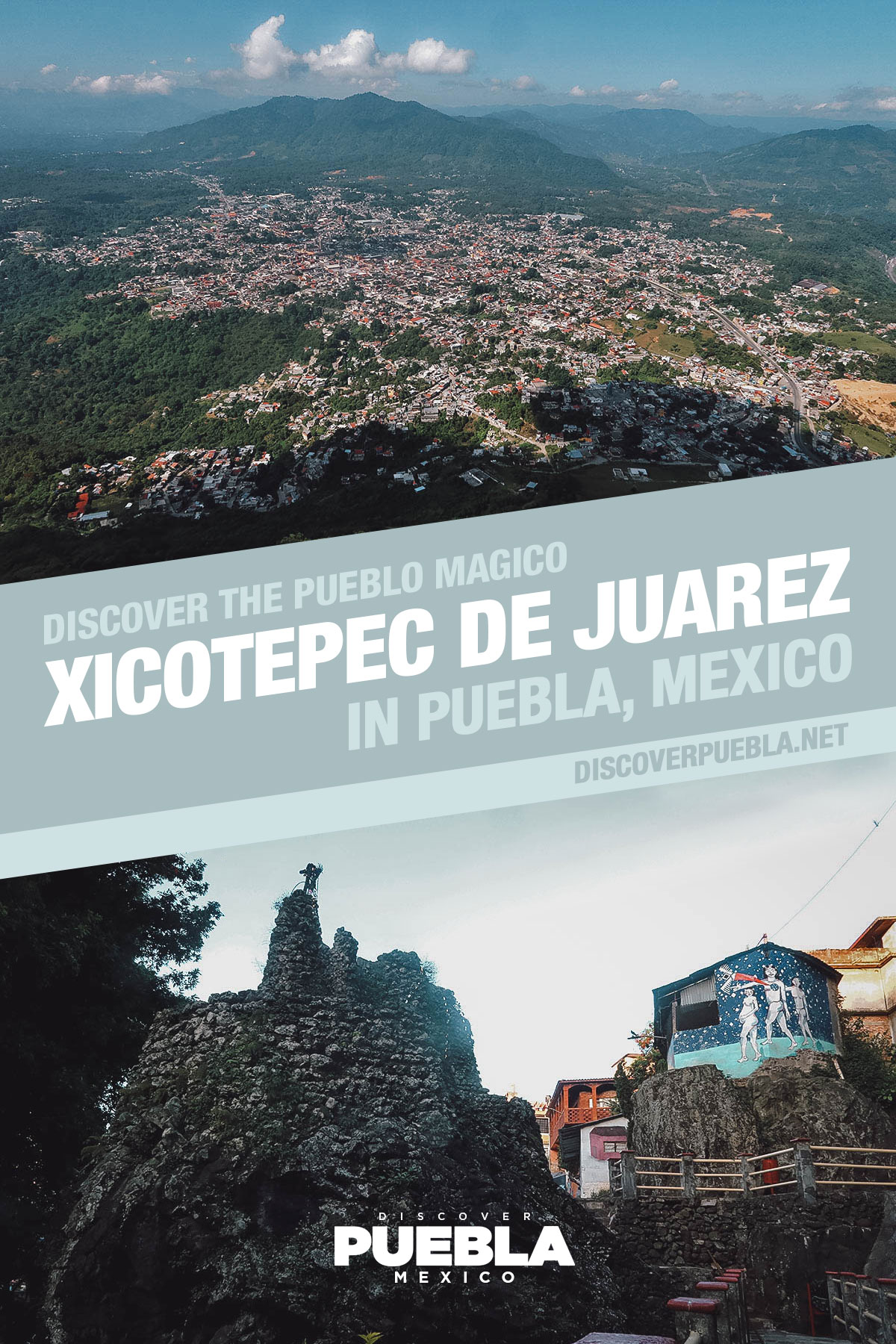
TABLE OF CONTENTS
MEXICO TOURIST CARD (FMM)
Depending on your passport, you may need to secure a tourist visa before entering Mexico. You can check iVisa.com for more information on Mexico tourist visas.
Whether or not you need a tourist visa, all visitors will still need an FMM (Forma Migratoria Múltiple) to be allowed entry into Mexico. Often referred to as a “tourist card”, it’s something you can get when you travel to Mexico by land or by air.
People entering Mexico by land can get one at the border (with a fee) while tourists flying into the country are usually provided one by their airline (cost included in the airline ticket).
You can also process the FMM ahead of time online through the INM website or iVisa.com. Click on the link to learn more about the FMM.
XICOTEPEC DE JUÁREZ AT A GLANCE
Xicotepec de Juarez is a pueblo magico (magical town) located in the northern part of Puebla state, around 13.7 miles (22 km) northeast of Huauchinango. Home to a population of around 80,500, it was declared a pueblo magico by Mexico’s Secretariat of Tourism in 2012.
Xicotepec de Juarez’s most famous attraction is Xochipila, a pre-Hispanic ceremonial center dedicated to Xōchipilli, the Aztec god of art, dance, and song. It was consecrated to Saint John the Baptist during the colonial period and is still used as an important site for indigenous cleansing ceremonies and other celebrations.
Like Cuetzalan and Tlatlauquitepec, Xicotepec de Juarez is known for its coffee production. I was chatting with a local at the zocalo and he told me that Xicotepec de Juarez is named after bees which play an important role in the pollination of coffee plants.
Intrigued, I did some digging and as it turns out, the town’s name stems from the Nahuatl words xicohtli, meaning “bumblebee”, and tepec which means “hill”. Put together, Xicotepec translates to “hill of the bumblebees”.

IS XICOTEPEC DE JUÁREZ SAFE?
I have mixed feelings about my time in Xicotepec de Juarez. It was apparent from the number of stares I was getting that this small town doesn’t get many foreign visitors. On their own, the surprised looks never made me feel unsafe but they did make me feel a little uneasy and self-conscious.
I walked into a taqueria for dinner and the owner looked like he had seen a ghost! He wasn’t nervous or upset, just surprised because it wasn’t everyday that a non-Mexican walked into his restaurant.
He was actually very kind and told me that it was rare to see foreigners in Xicotepec de Juarez. He asked me where I was from, what I was doing there, and what I thought of Mexican people as a whole. We had a great conversation that included him Googling my home country because he had never heard of it!
That experience sort of repeated itself throughout my stay. I never felt unsafe or threatened but clearly, people noticed and took an interest in me. A couple of locals were even happy to tell me more about their town, which was nice.
Regardless of how you feel about drawing attention, it’s important to remember that Puebla is considered one of the safest states in Mexico. Aside from its amazing regional cuisine, it’s one of the reasons why we decided to make it our base in Mexico.
As long as you prioritize safety and follow the usual protocols – don’t wear anything flashy, stay in populated areas, don’t walk around alone at night, etc – then you should have an incident-free time in Xicotepec de Juarez.
The US, Canada, and UK governments give general advisories for travel to Mexico but I highly recommend bookmarking the Puebla and Xicotepec de Juarez Tripadvisor forums as well. If there are any recent events that you need to know about, then there’s a good chance you’ll learn about them there first.
BEST TIME TO VISIT XICOTEPEC DE JUÁREZ
Xicotepec de Juarez experiences a rainy and humid climate for a good part of the year. I went in August – which is one of the rainiest months – but I was lucky to experience mostly sunny weather during my stay.
If you want to go when precipitation is historically at its lowest, then you may want to visit sometime between December and March. You can check Weather Spark for more on Xicotepec de Juarez’s climate.
If you aren’t concerned about the weather, then the most interesting time to visit Xicotepec de Juarez is on June 24 for the annual Xochipila celebration. On that day, cleansing ceremonies and indigenous dances are held at the shrine day and night. More on that later in this guide.
HOW TO GET TO XICOTEPEC DE JUÁREZ
There are many ways to get to Xicotepec de Juarez from wherever you are. This guide assumes you’ll be coming from Puebla City, Mexico City, or the other nearby pueblos magicos in Puebla.
From Puebla City
Futura runs direct buses from Puebla CAPU (main bus station) to Xicotepec de Juarez. The journey takes around 3 hours and costs MXN 232 (August 2022).
From Mexico City
I haven’t done this but according to Rome2Rio, you can catch direct Futura buses to Xicotepec de Juarez from either Indios Verdes station or Central de Autobuses del Norte in Mexico City.
From Other Pueblos Magicos
A few of these pueblos magicos in Puebla are located in the same general area so you can travel from one to the next without having to go back to Puebla City. Here’s how you can get to Xicotepec de Juarez from nearby magical towns.
FROM HUAUCHINANGO: Huauchinango is just 13.7 miles (22 km) south of Xicotepec de Juarez. You can travel between towns on a Conexion bus for just MXN 20.
FROM ZACATLAN DE LAS MANZANAS: When I was in Zacatlan, I learned about a bus line that can take you directly to Xicotepec de Juarez. I assume it goes the other way as well.
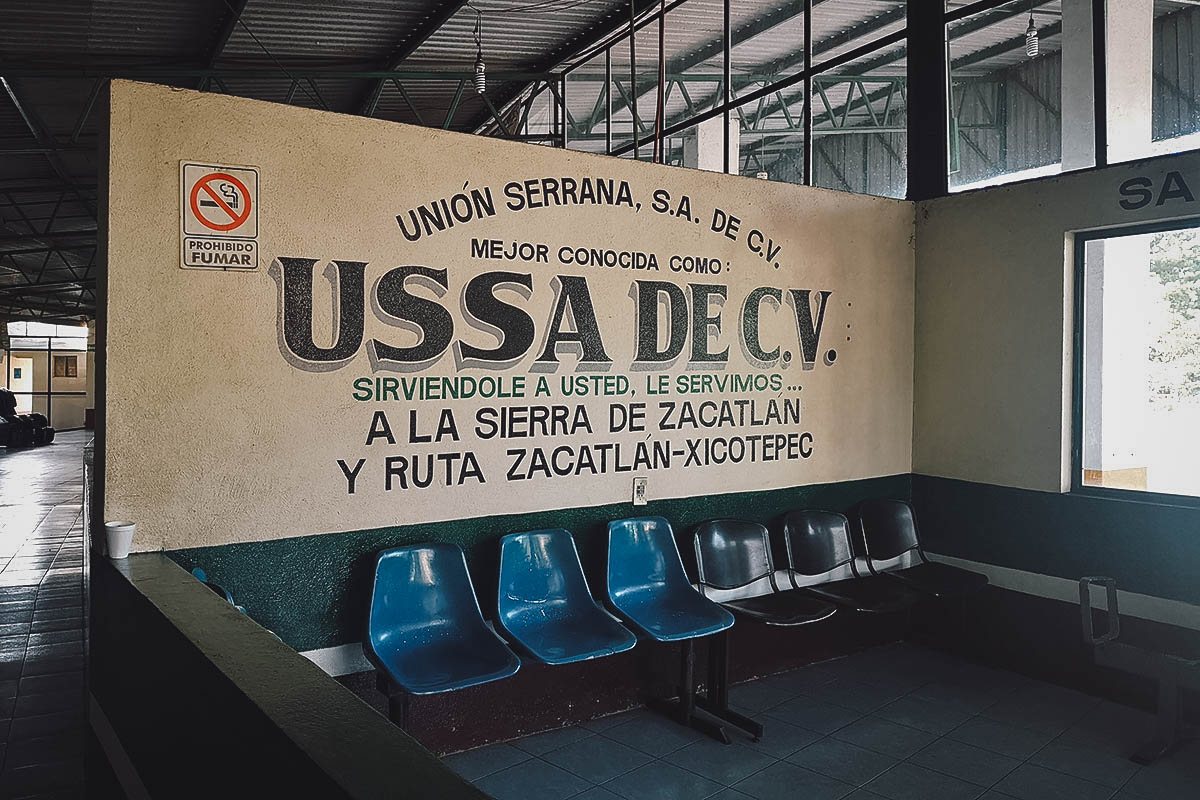
By Rental Car
Exploring Mexico in your own car is a popular way of seeing the country, especially for people driving in from the US. If you’d like to rent a car to visit Xicotepec de Juarez, then you can do so through rentalcars.com.
WHERE TO STAY IN XICOTEPEC DE JUÁREZ
There aren’t many choices but I didn’t have a problem finding a hotel room in Xicotepec de Juárez. I stayed at Hotel Villa de Cortez which is conveniently located around the corner from the zocalo. Here are a few hotel options:
If you don’t think these hotels are right for you, then you can do a search on Booking.com, Agoda, or Airbnb for alternate listings. You can also search for hotels in Xicotepec de Juarez using the handy map below.
THINGS TO DO IN XICOTEPEC DE JUÁREZ
1. Start in the Zocalo
The zocalo or main square is a great place to start your visit to any new Mexican city. Zocalos in Mexico are always pleasant but the main square in Xicotepec de Juárez was one of my favorites in Puebla.
Typically found at the zocalo, these letras gigantes or giant letters spelling out the town’s name are a popular photo backdrop in Mexico. In Xicotepec de Juárez, there’s the added bonus of this interesting sculpture to spruce up your Instagram feed.

I was here bright and early and one local was eager to tell me about the significance of this sculpture of hands cradling coffee beans. I knew Xicotepec de Juárez was known for its coffee but I didn’t know the vital role bees played in its production.
It was this same local who told me that Xico- in Xicotepec means “bumblebee”. These bees pollinate coffee plants and were thus key players in the coffee production process. Interesting!

Kiosko
Visit enough zocalos in Mexico and you’ll begin to notice common features. A large central kiosko or gazebo is one of them.
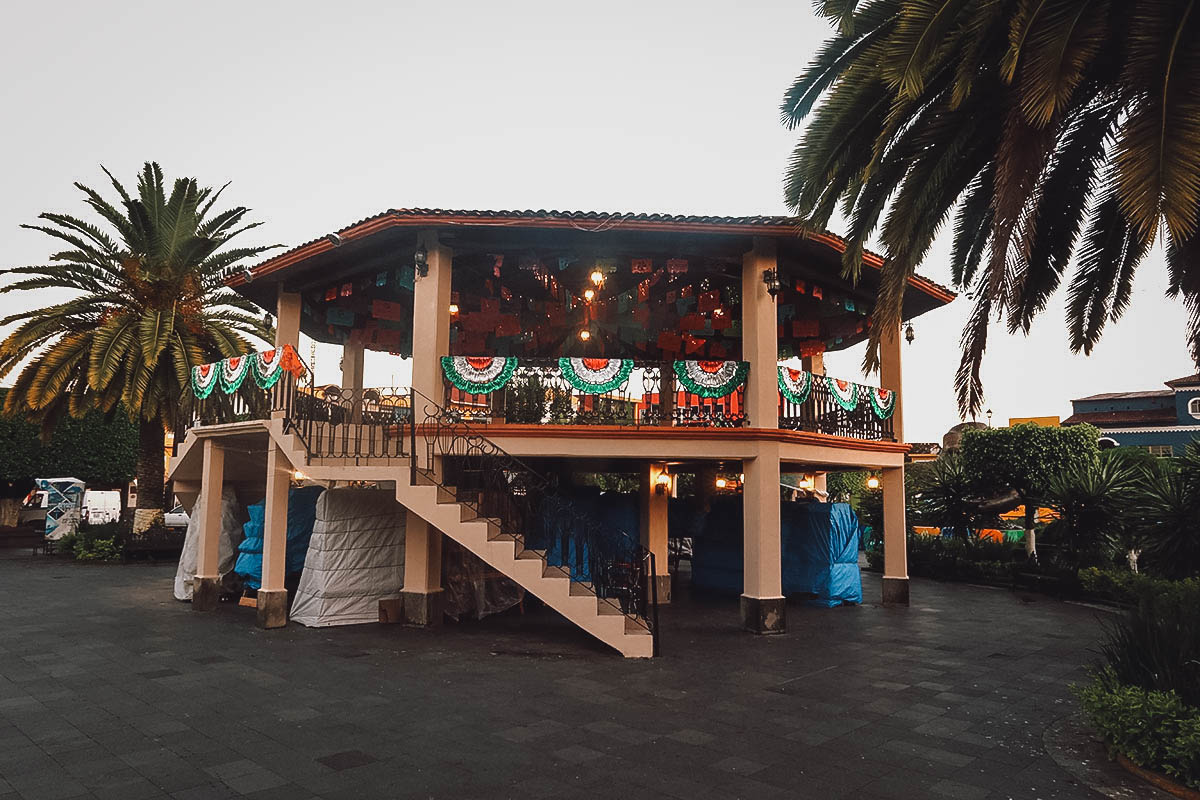
Palacio Municipal
Another constant is the palacio municipal or municipal palace.
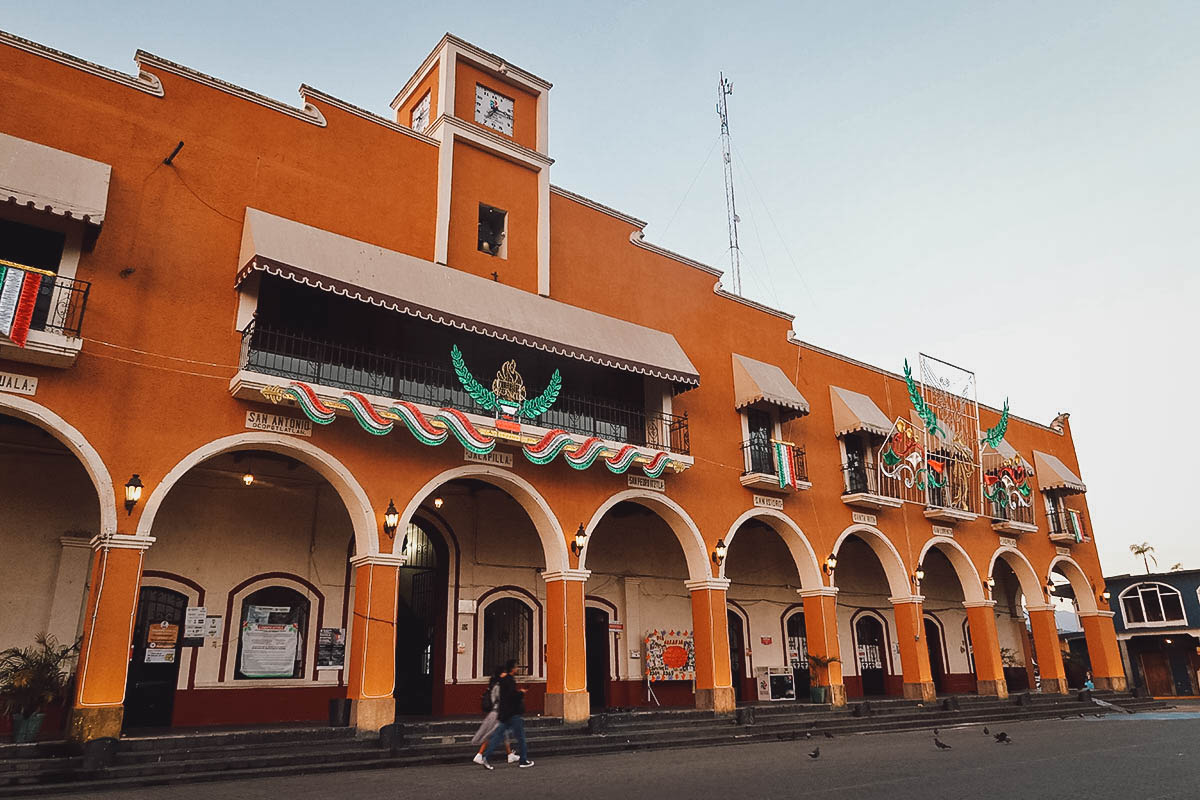
Some of these municipal palaces are worth entering because you’ll often find large colorful murals inside.
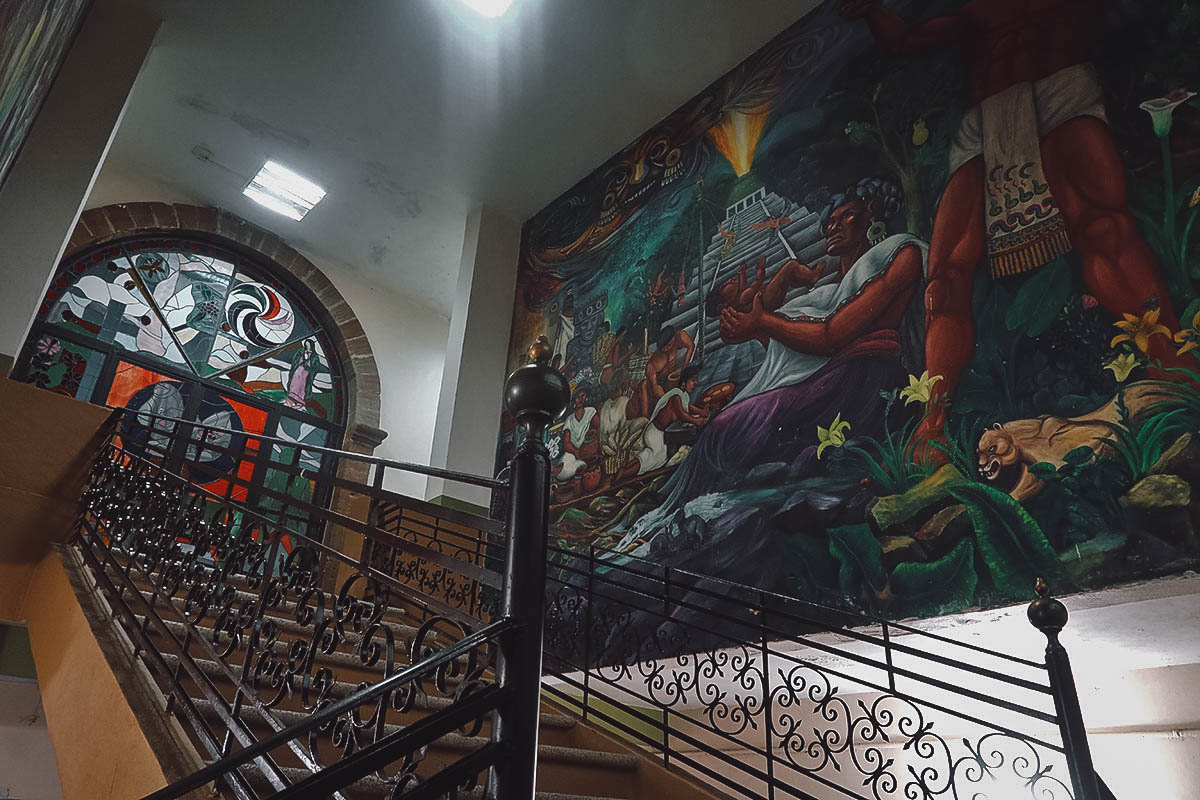
2. Visit Parroquia de San Juan Bautista
Not too far from the zocalo is Parroquia de San Juan Bautista, the biggest and most impressive church in Xicotepec de Juárez. It’s a 16th-century church built by the Augustinians.
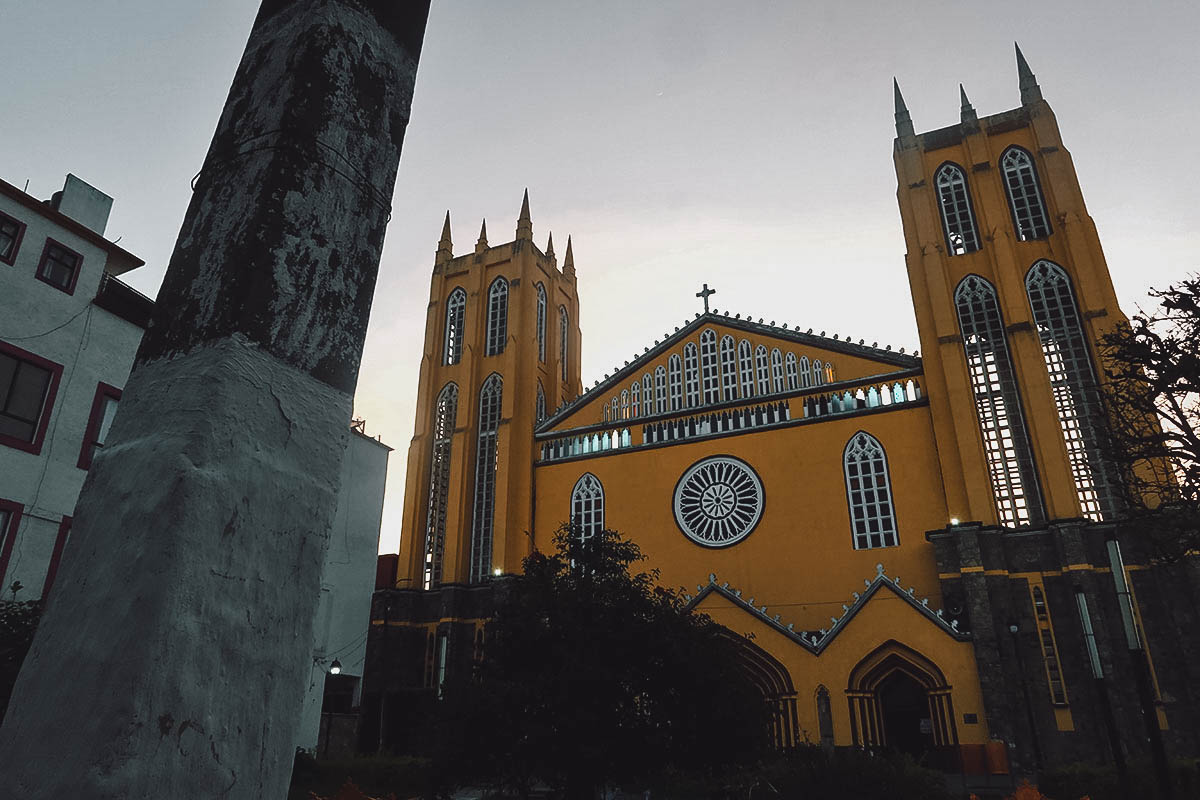
Here’s what the inside of the church looks like. This was one of the simpler church interiors I found in Mexico.
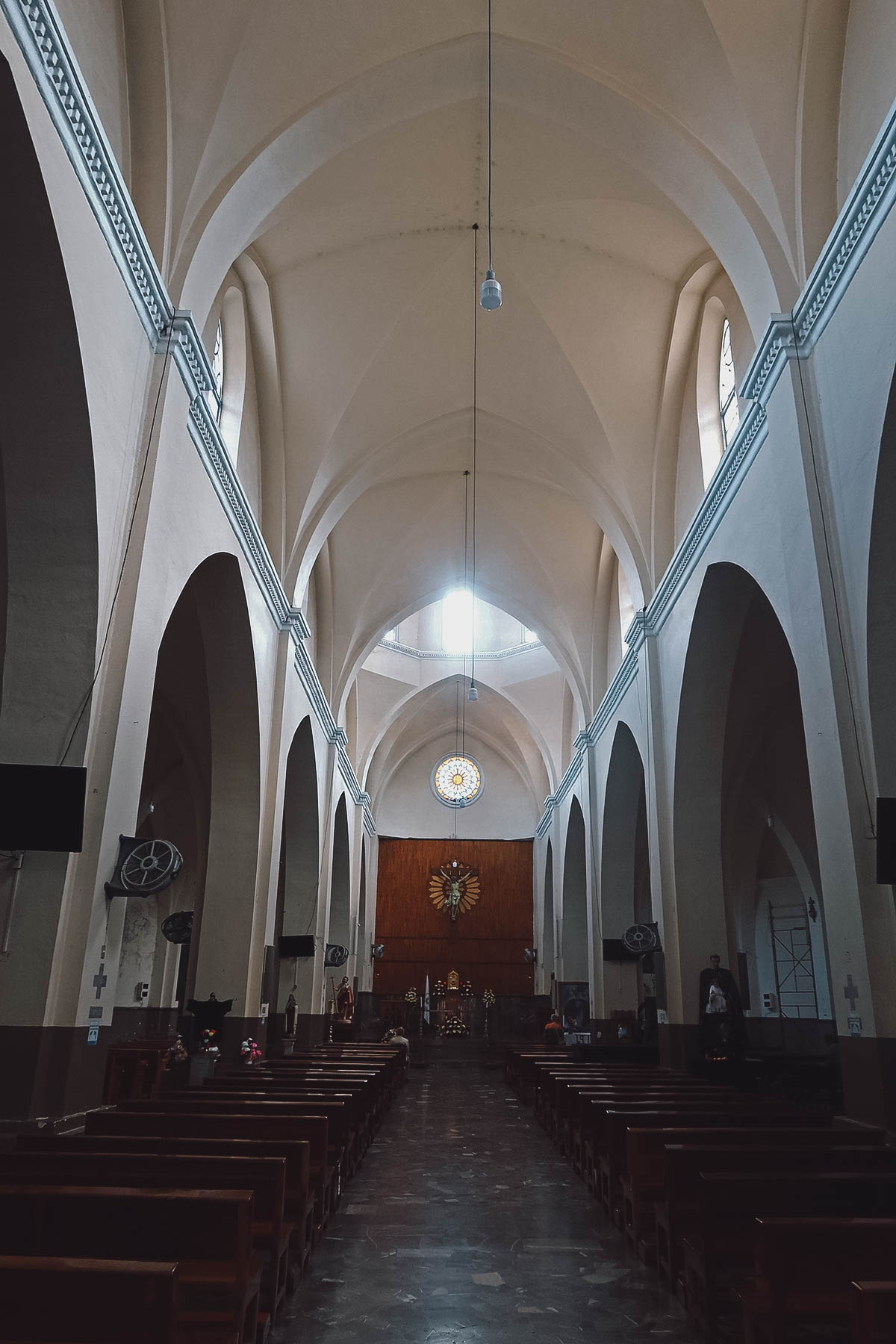
3. Make a Stop at Museo Casa Carranza
Located just off the zocalo is Museo Casa Carranza, a small museum dedicated to Venustiano Carranza, the first president of the new Mexican republic.
According to the museum’s curator, Venustiano Carranza isn’t from Xicotepec de Juárez (he was born in Coahuila) but he was assassinated near here, in Tlaxcalantongo. This old house where the museum is located was where his body was kept for three days before being taken to Mexico City. During that time, Xicotepec de Juarez was recognized as the capital of the Mexican republic.
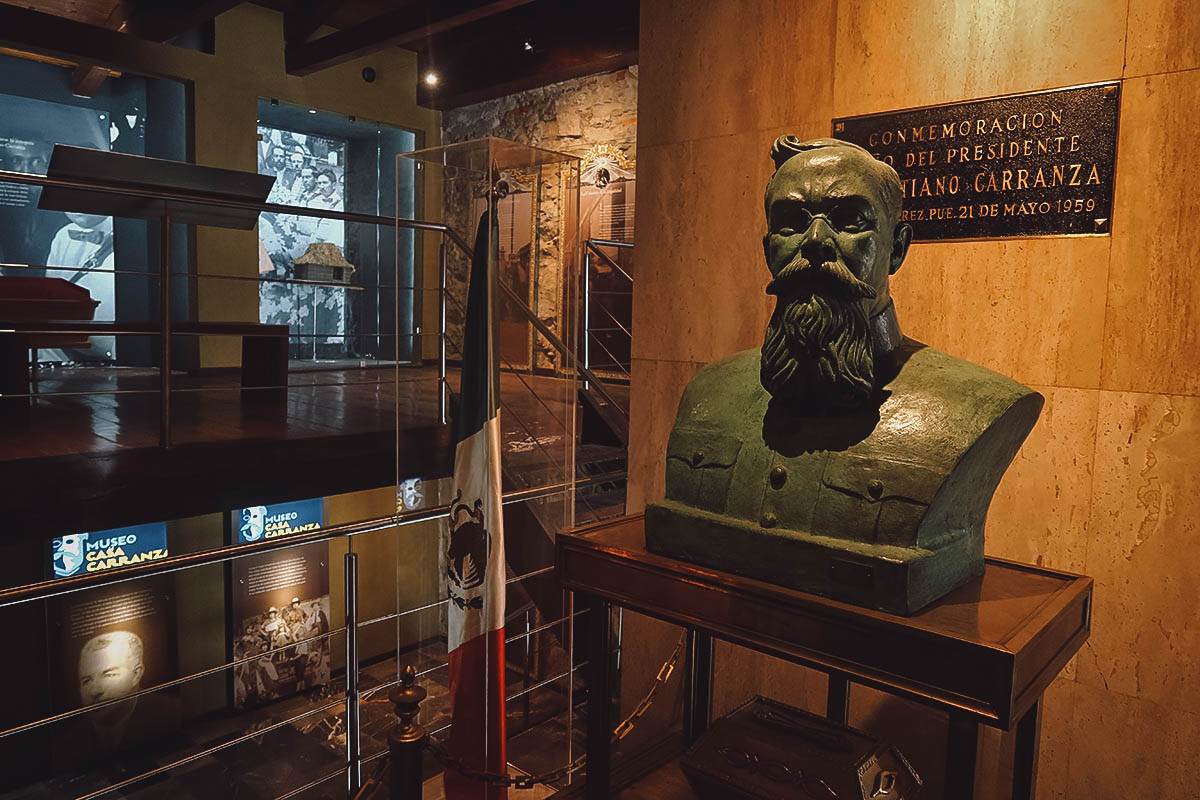
Museo Casa Carranza is tiny so it shouldn’t take you more than 15-30 minutes to go through all the exhibits.
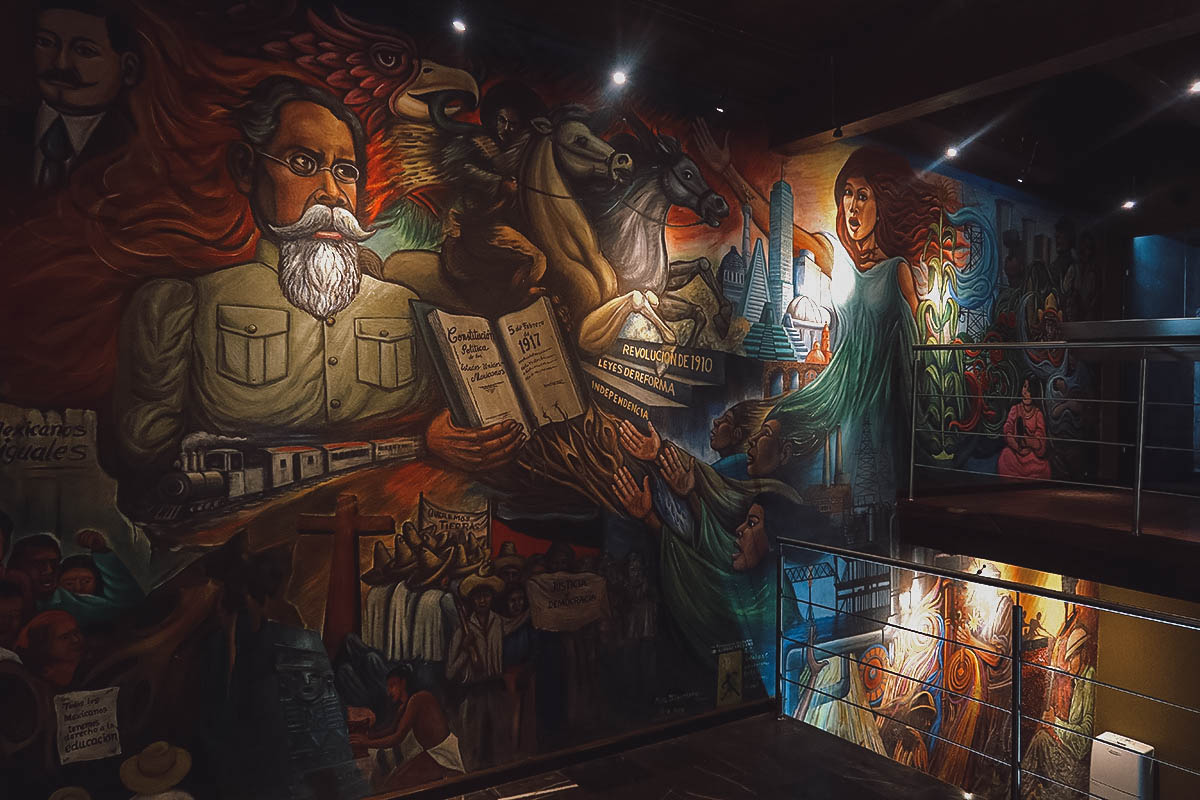
You’ll find photographs and a few of the former president’s personal effects on display here.
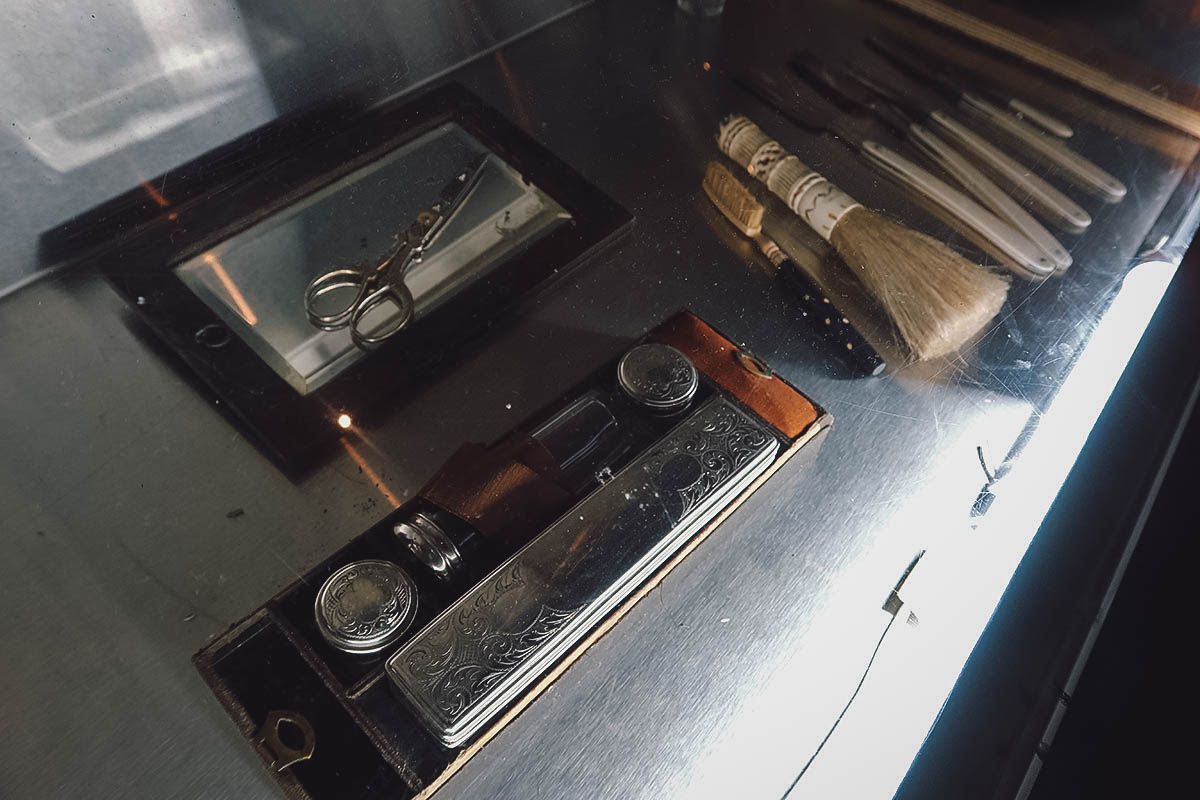
4. See the Indigenous Shrine Known as Xochipila
Xochipila is the main attraction in Xicotepec de Juárez and what makes the town unique. As described, this pre-Hispanic ceremonial center is dedicated to the Aztec god Xochipilli and is said to be one of just two ceremonial centers of its kind in Latin America. The other is hidden in the jungles of Peru.
Xochipila was built in a part of town where two small streams meet. Characterized by various natural elements, it’s described as a mystical area with magical forces inhabited by gods. The shrine itself is made of piled stones and stands over 16 ft high (5 m) with an elliptical base of around 36 ft (11 m) in diameter. The entire structure is estimated to weigh over 13.5 tons.
This indigenous shrine is interesting enough but what makes Xochipila even more fascinating is the small cross you’ll find at its peak. Christian colonizers consecrated Xochipila to Saint John the Baptist hence the symbols from both beliefs at this one site. It’s said that the mestizo figure known as San Juanito Techahalco was born from the union of these two faiths and cultures.

You can’t see them in these photos but there are steps leading to the top and bottom of the structure. There are signs asking you not to climb the structure so please be respectful of that.
During my visit, there was a family of Mexicans at the bottom of the structure making an offering. They had an altar with different offerings like cigarettes, fruits, and cans of beer. One man was holding a dead chicken while the woman – whom I presumed to be his wife – was waving a smoke-producing object (incense sticks?) and reciting a prayer in a language I couldn’t understand. Nahuatl perhaps? Out of respect, I didn’t take any pictures but it was a fascinating sight to see.
Based on what I’ve read about Xochipila, that family may have been performing a cleansing ceremony. Cleansing ceremonies are carried out for the purpose of curing ailments and disease.
Xochipila is fascinating at any time of the year but it must be incredible to witness the celebrations of June 24. Pilgrims come from all over to perform indigenous dances and rituals throughout the day and night.
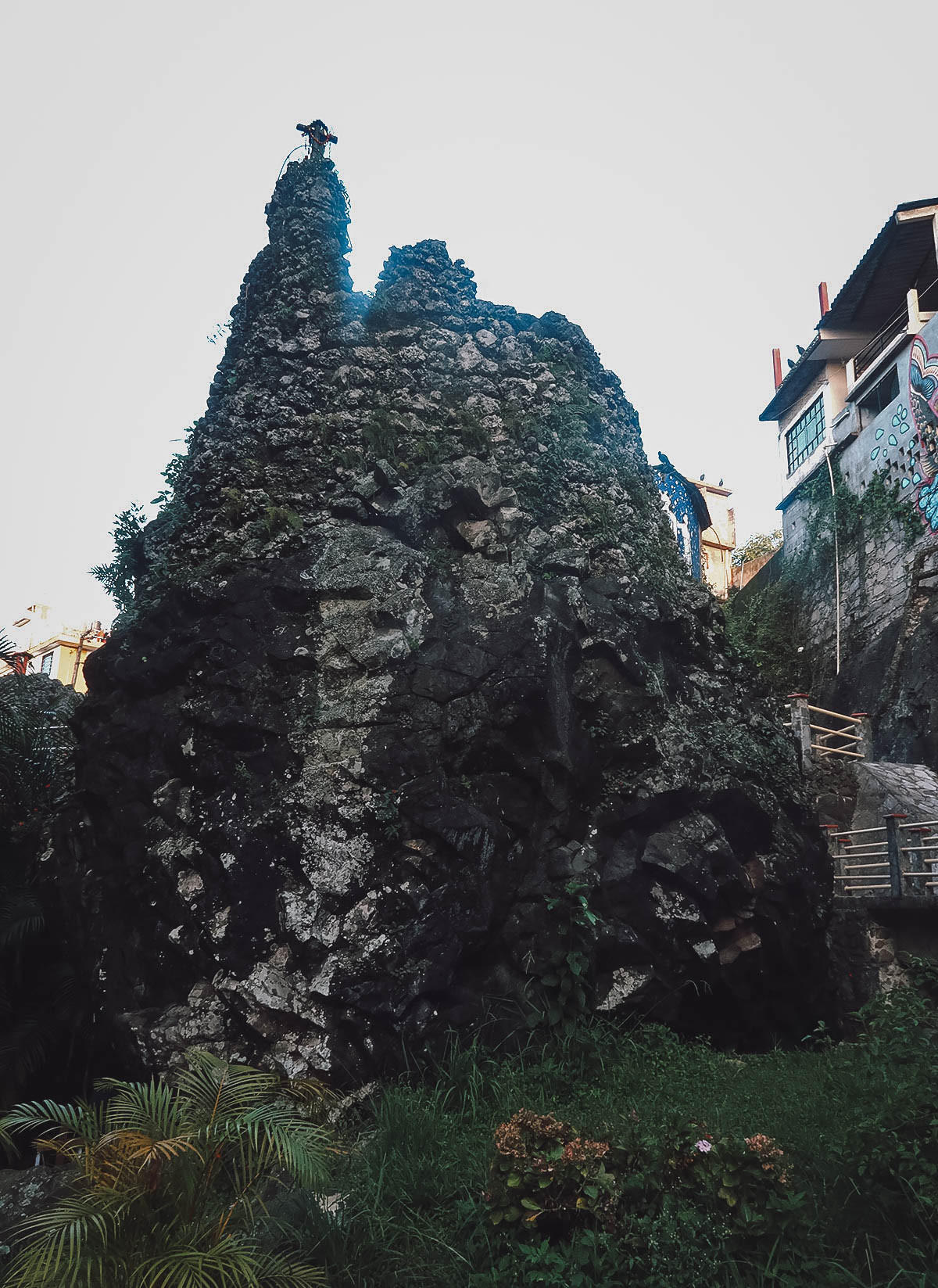
Mexicans love murals. You’ll find colorful murals adorning buildings in Mexico and the area around Xochipila is no different.
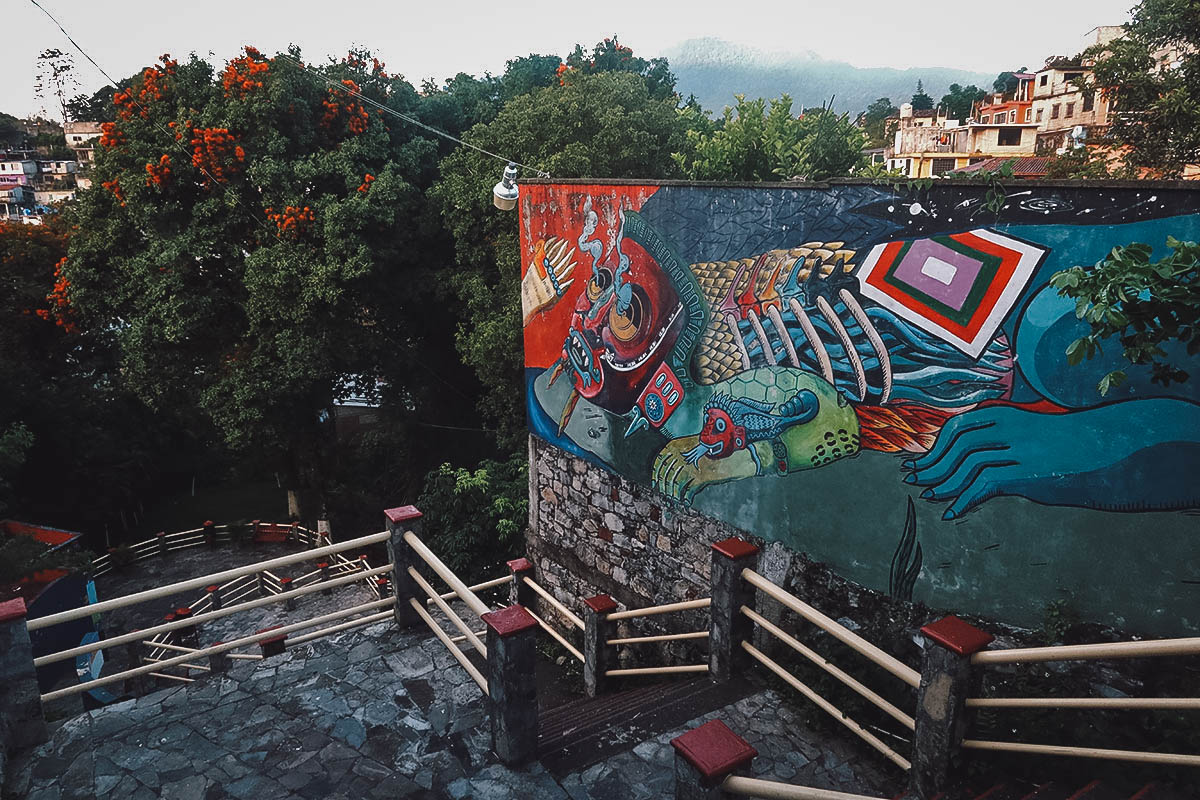
As eye-catching as these murals are, I’m sure they have deeper meanings that are unfortunately lost on foreigners like myself.

Thanks to the kind local I met at the zocalo, I understood the significance of this one.
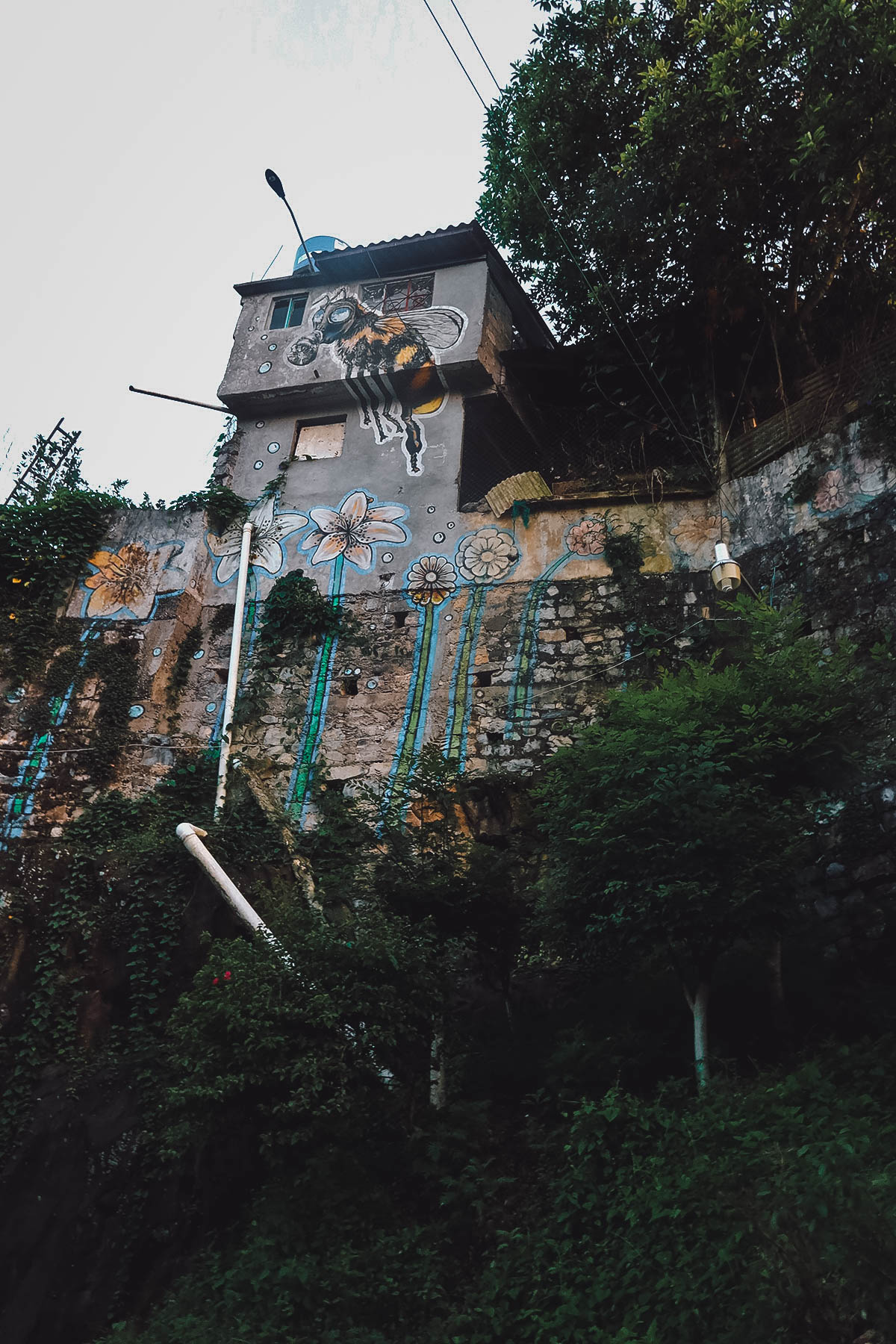
5. Visit the Monumental Virgen de Guadalupe
Located on the outskirts of town is this massive statue of the Virgin of Guadalupe. Built in 2006, it watches over Xicotepec de Juarez at a towering 75 ft (23 m).
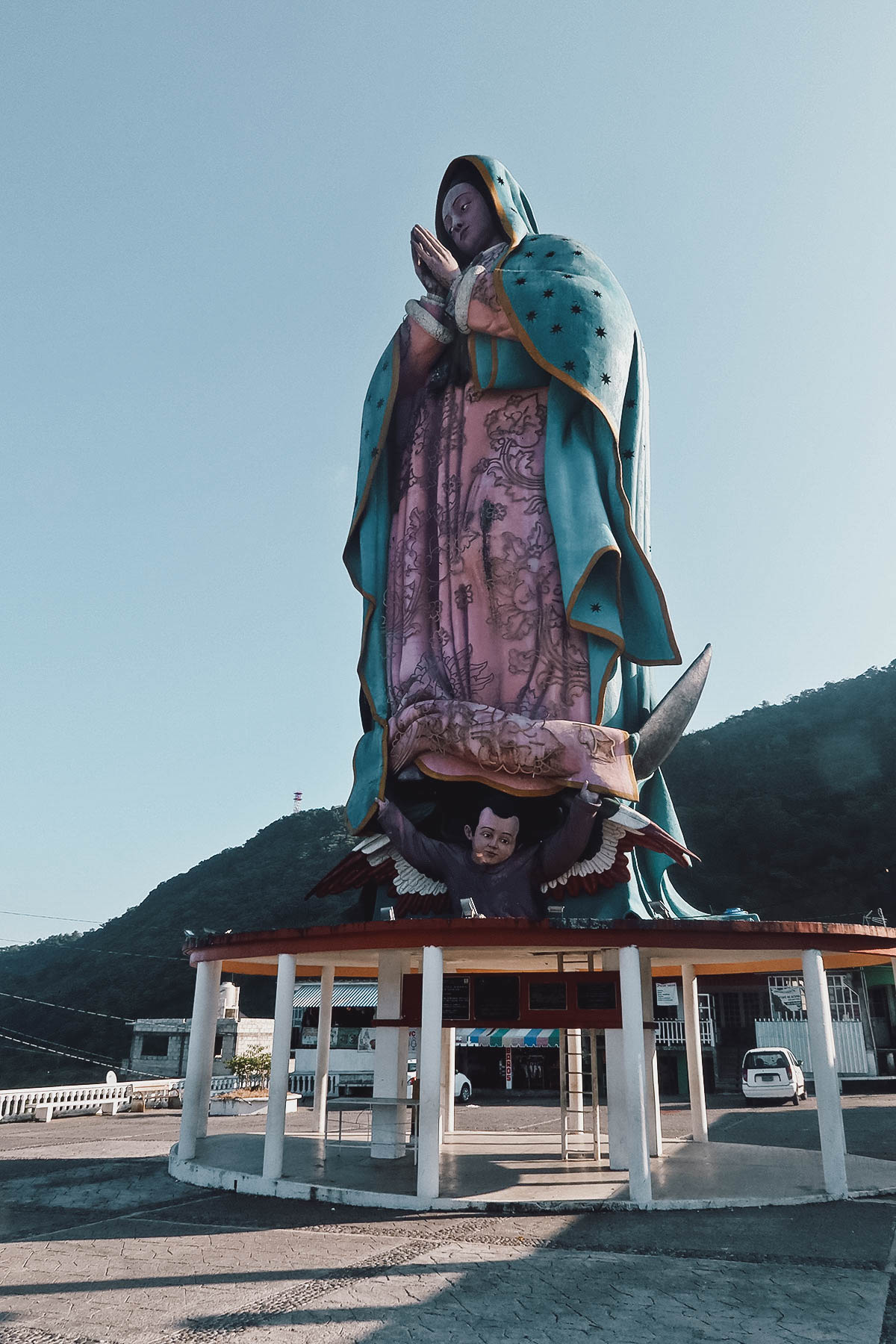
The statue’s size is impressive but what’s even more impressive is the view. You’ll have a great view of Xicotepec de Juarez from here.

I came here for the Virgin statue but what really caught my eye was that giant cross sitting on top of the mountain. If the views from the statue’s base were breathtaking, then I could only imagine what the views from up there must be like. I had to find out.

6. Enjoy the View From Majestuoso Cruz Celestial
Majestuoso (or Mirador) Cruz Celestial is a lookout point built at the apex of the hill behind the Virgin statue. On it is this large modern cross and a glass platform offering the most spectacular views of Xicotepec de Juarez and the surrounding mountains.
Majestuoso Cruz Celestial is located less than a 3-mile drive (4.6 km) from the Virgin statue. I didn’t have a car so I walked the entire way. It took me over an hour to get there.
Before I show you the view, I just wanted to say that I don’t think people are really meant to walk up here. Most people drive in a car. A few cars passed me but I was the only person going up on foot.
To get to the mirador, you need to walk along the side of a highway before going up the hill. There’s no real walking path so it can be dangerous, especially with cars and buses constantly zipping by. On top of that, I was almost charged by a pack of dogs while I was walking up the mountain.
For your safety, it’s best to drive up to the mirador or arrange for transportation at the Tourist Information Center in town. It’s located just off the zocalo.
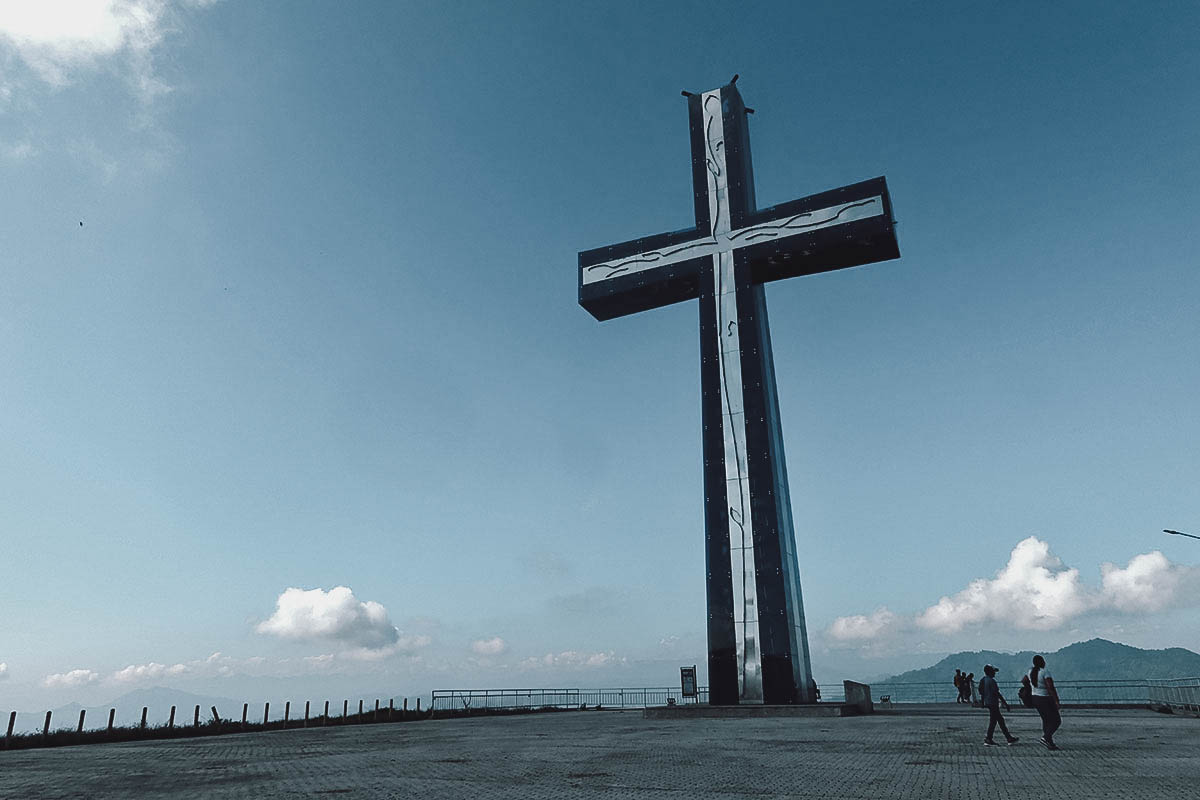
The mirador’s platform is made mostly of concrete but the edge facing the town is made from steel and glass. It was a bit nerve-wracking walking to the edge but the views from up here will absolutely take your breath away.
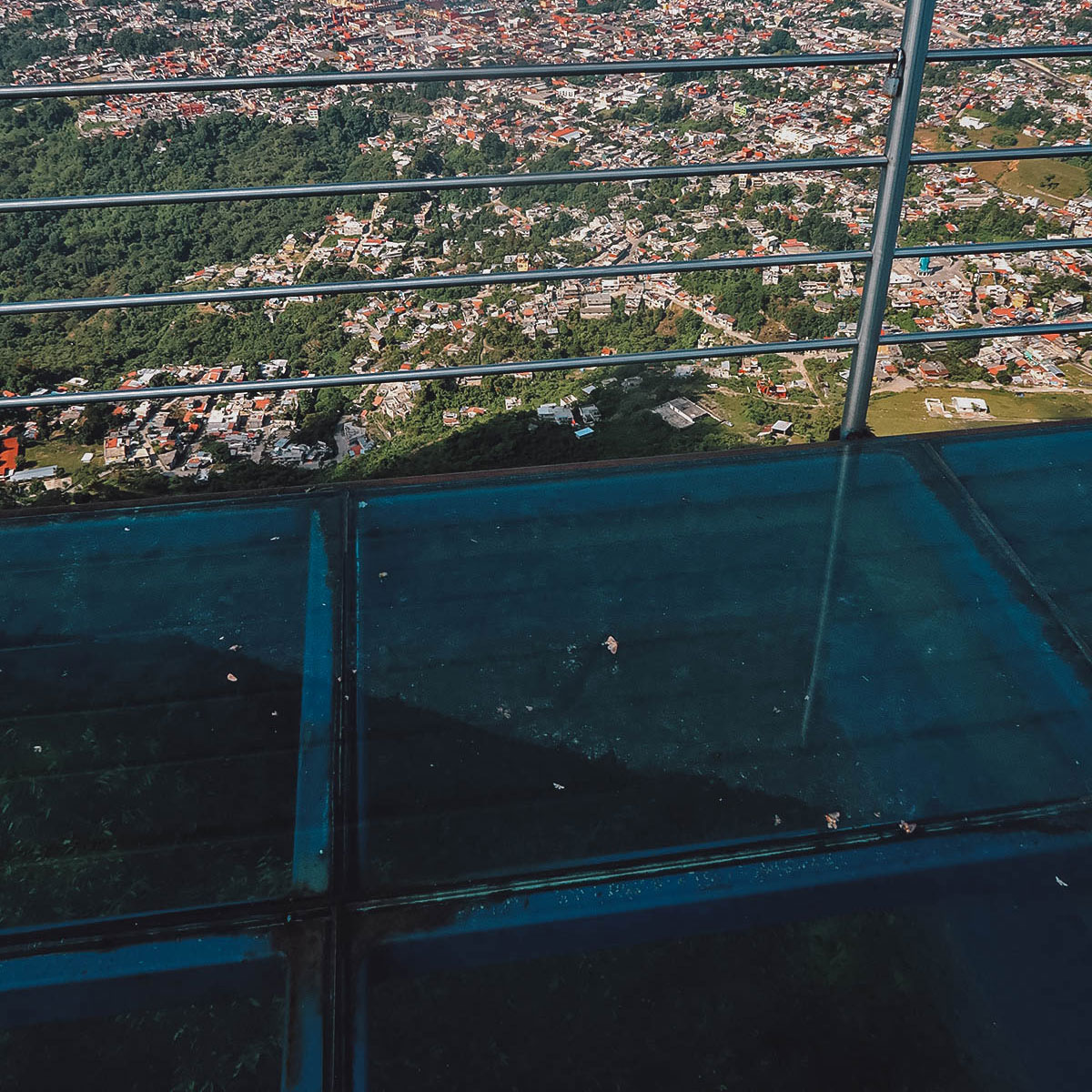
Behold Xicotepec de Juarez in all its magic! I’ve enjoyed many great views in Mexico but this was without a doubt the most spectacular. Seriously, WOW!
If you have your own car or can arrange for transportation to get up here, then I highly recommend it. The views from up here are second to none.

7. Go on a Coffee or Biking Tour
I didn’t have time to do this but the brochure I got from the Tourist Information Center had information on biking trails and coffee plantation tours. Xicotepec de Juárez is probably one of the best places in Puebla to learn about coffee production so if that sounds interesting to you, then you should visit the tourism office at the zocalo for more information.
POBLANO FOOD GUIDE
Puebla is home to some of the tastiest and most interesting regional food in Mexico. I asked a few locals in different parts of Mexico what their favorite state for food was and most of them said Puebla. You may have heard of mole poblano and chiles en nogada but there are many other regional dishes that you need to try in Puebla.
If you have a taste and curiosity for local food, then be sure to check our Poblano food guide for suggestions on what dishes to try in Xicotepec de Juarez and Puebla.
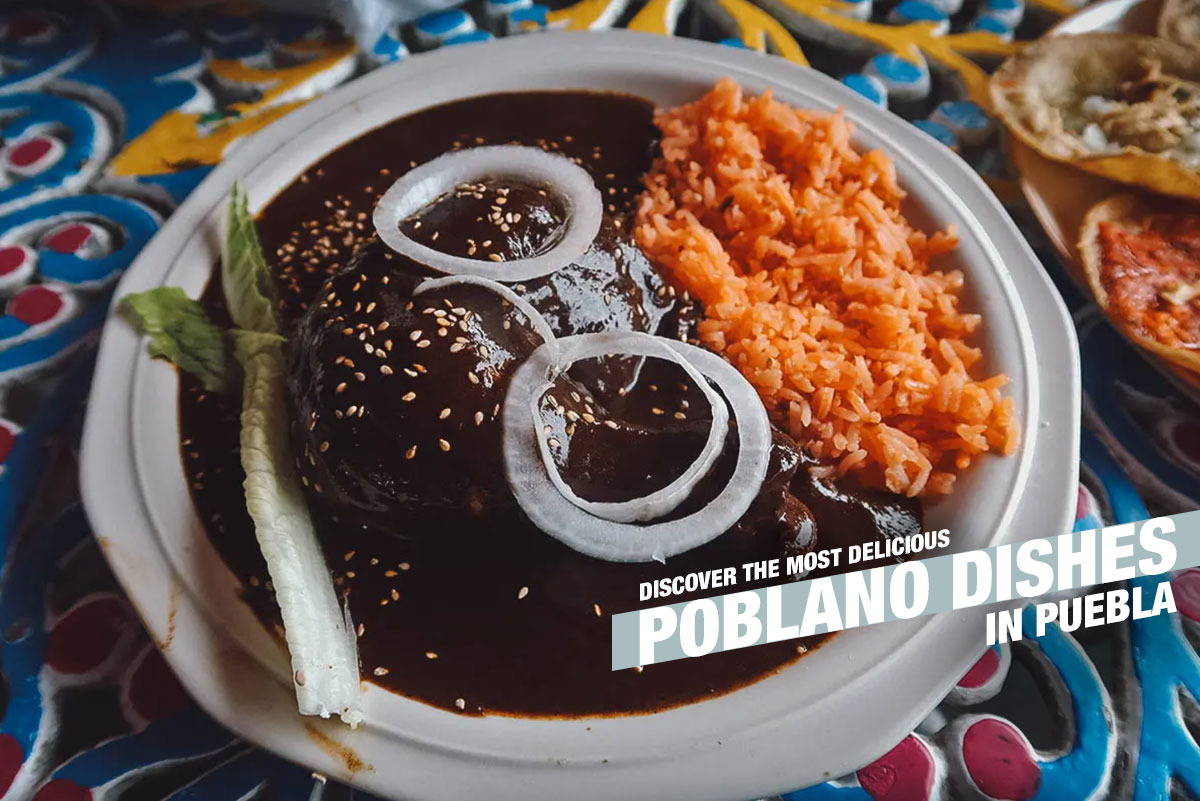
WHERE TO EAT IN XICOTEPEC DE JUÁREZ
1. Tacos los Cuñados
I’m a sucker for tacos so when I read reviews proclaiming Tacos los Cuñados to be the best taqueria in Xicotepec de Juárez, I made sure to enjoy my first meal there. The reviews were right. The tacos here are delicious.
Pictured below is an order of five al pastor tacos. They offer tacos topped with bistec, chorizo, cecina, and suadero as well.
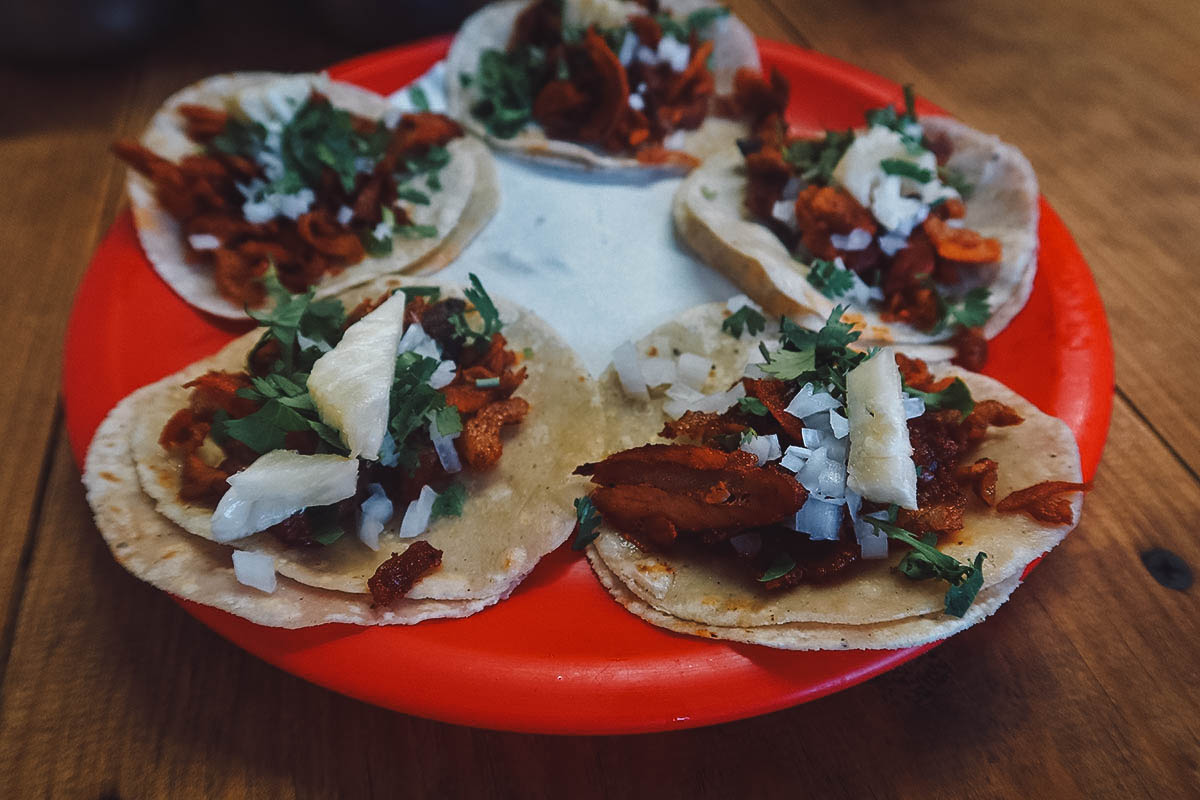
I wanted to try one of their specialties so I got these gringas too. Gringas are basically a version of tacos al pastor made with cheese and flour tortillas.
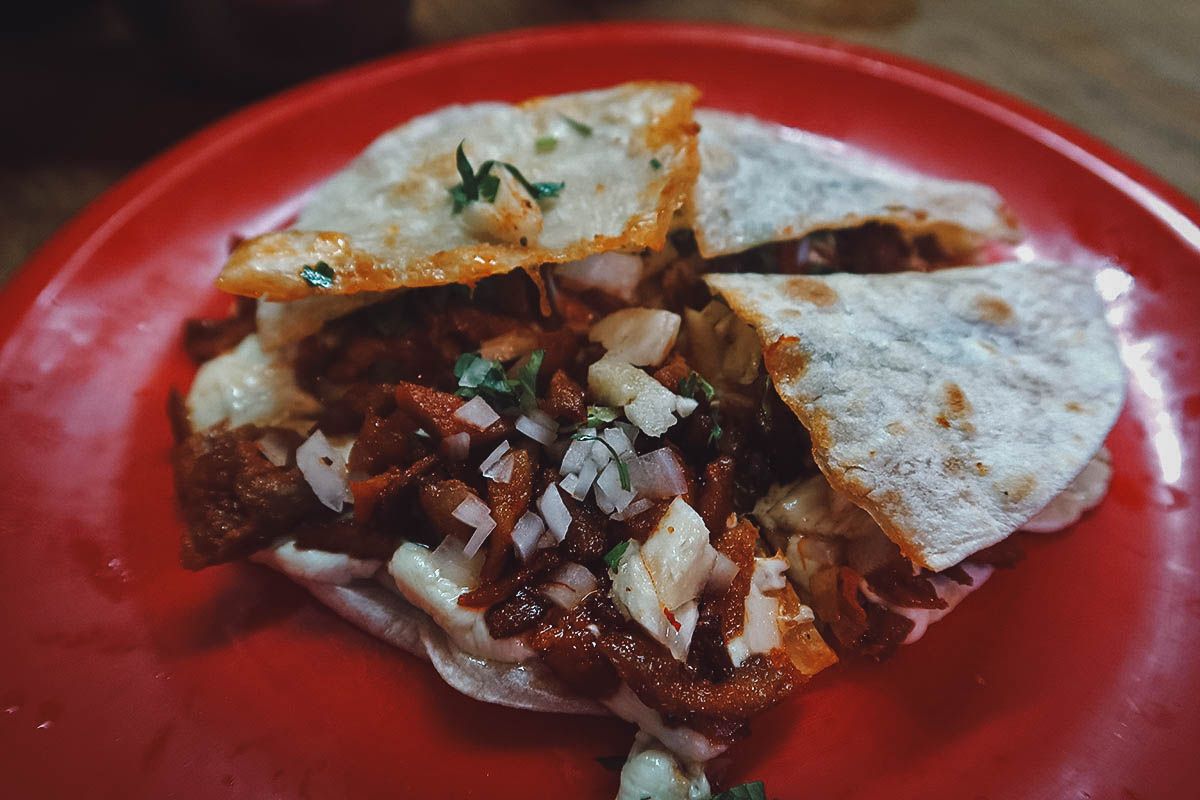
Tacos los Cuñados is conveniently located just a block away from the zocalo. If you’re addicted to tacos like I am, then you should make a stop here.
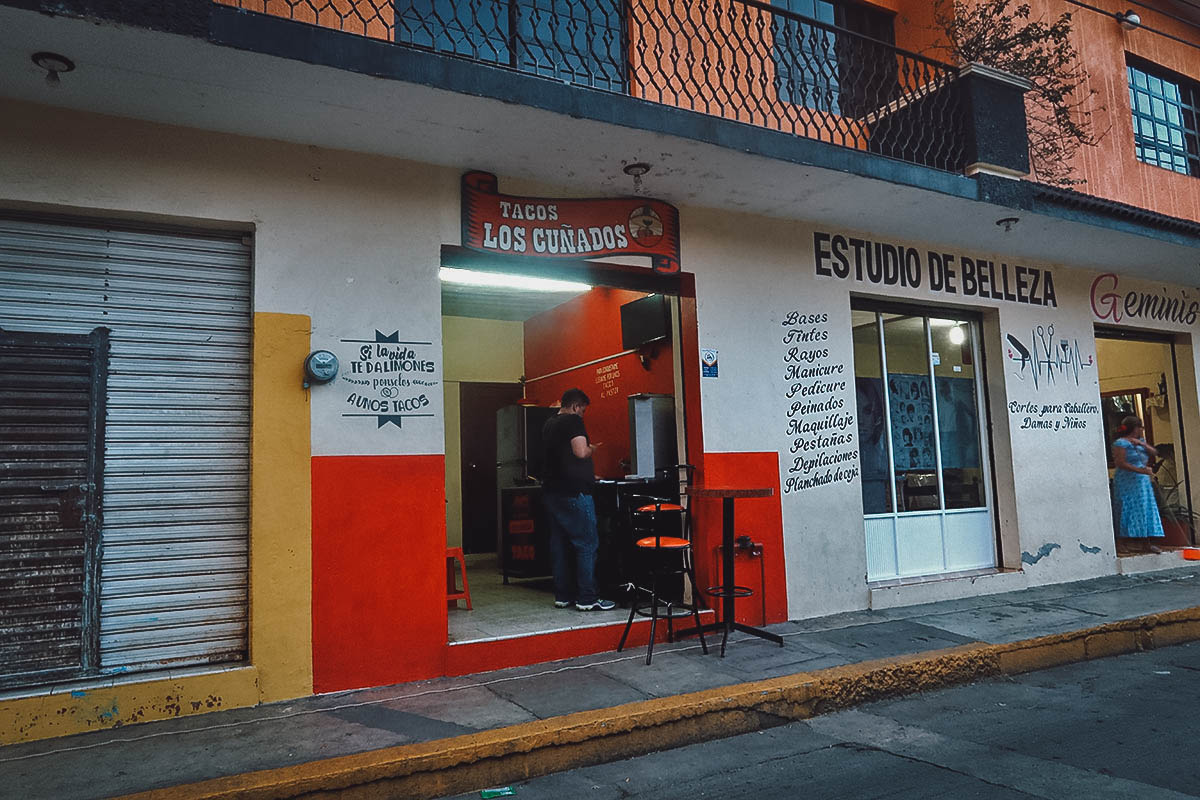
2. Tortas Don Benito
Do you know what I like almost as much as tacos? Tortas. Torta is the Spanish word for a Mexican sandwich.
Don Benito is a popular spot for tortas in Xicotepec de Juárez. They offer other dishes on their menu but what they’re really known for are their sandwiches. If I remember correctly, I got the milanesa de pollo or chicken milanese.

Being in Mexican coffee country, I had to wash my tasty sandwich down with a cup of Xicotepec de Juarez coffee.
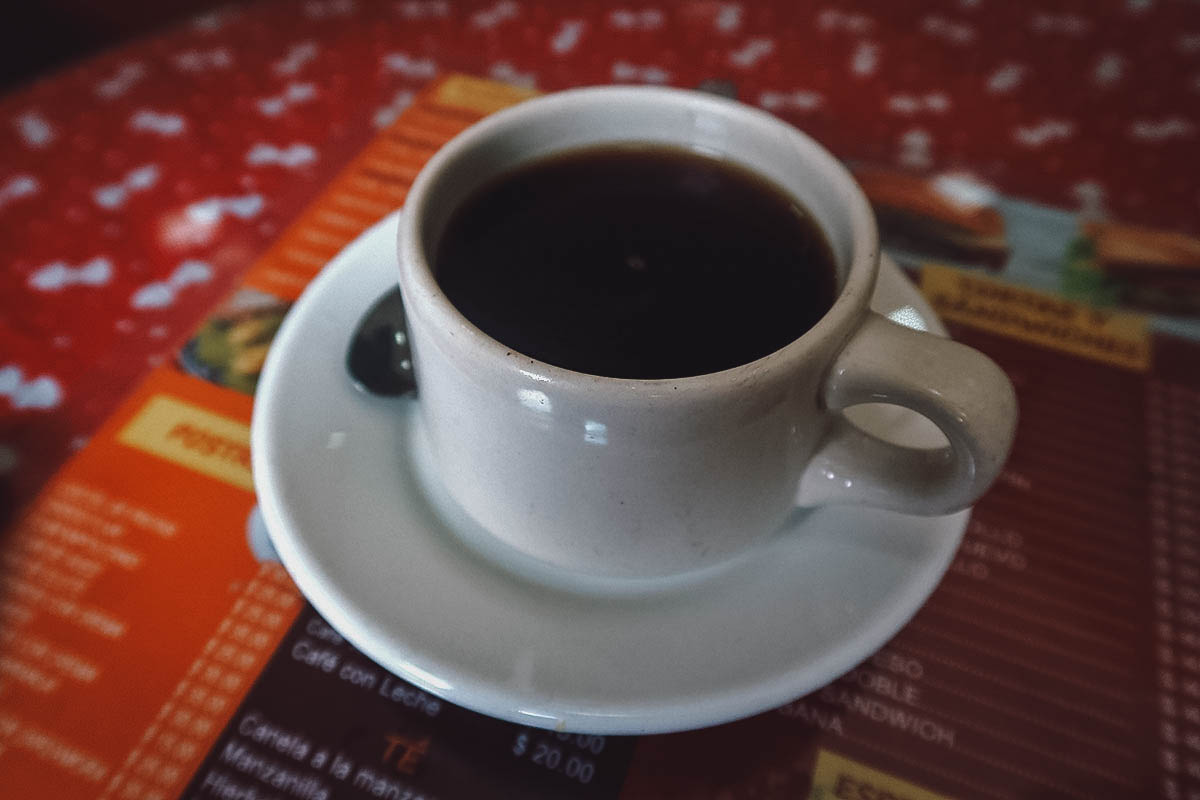
Tortas Don Benito is conveniently located just off the zocalo. This place is popular so you may have to wait a bit during peak lunch hours.
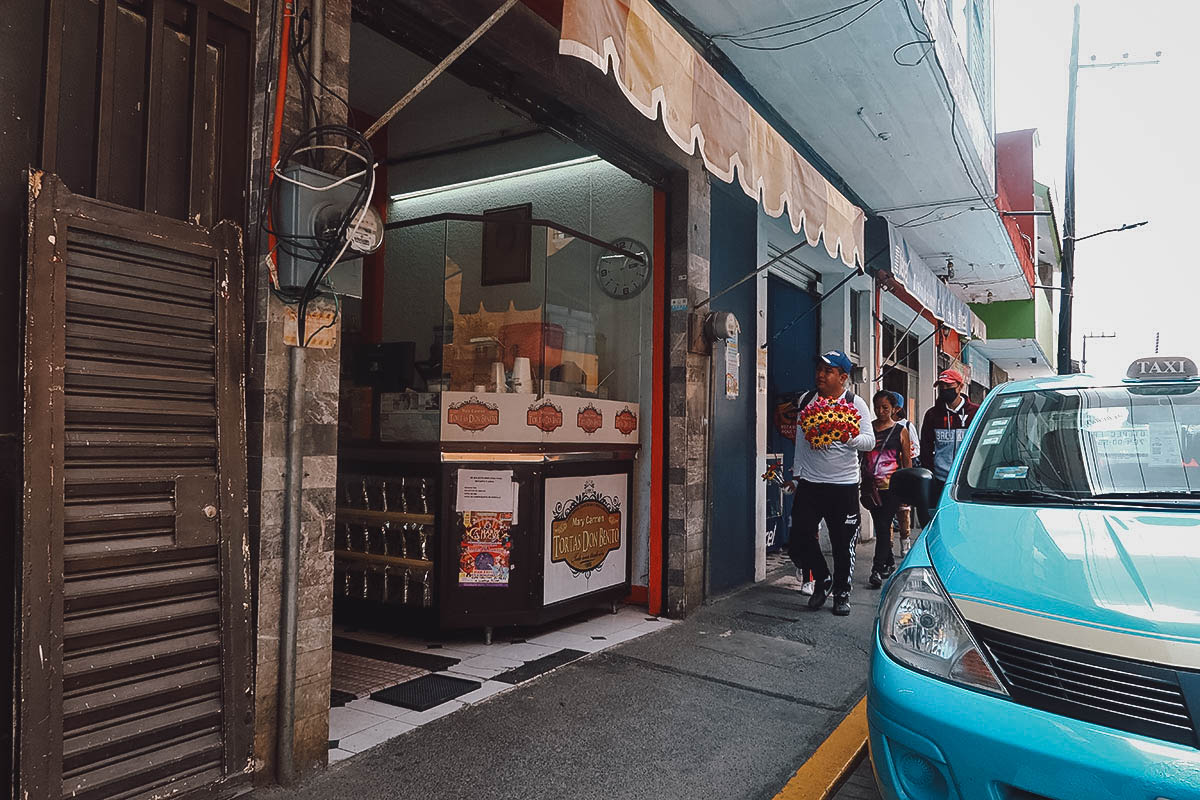
POINTS OF INTEREST IN XICOTEPEC DE JUÁREZ
To help you navigate to these points of interest in Xicotepec de Juarez, I’ve pinned them all on this map. Click on the link for a live version of the map.
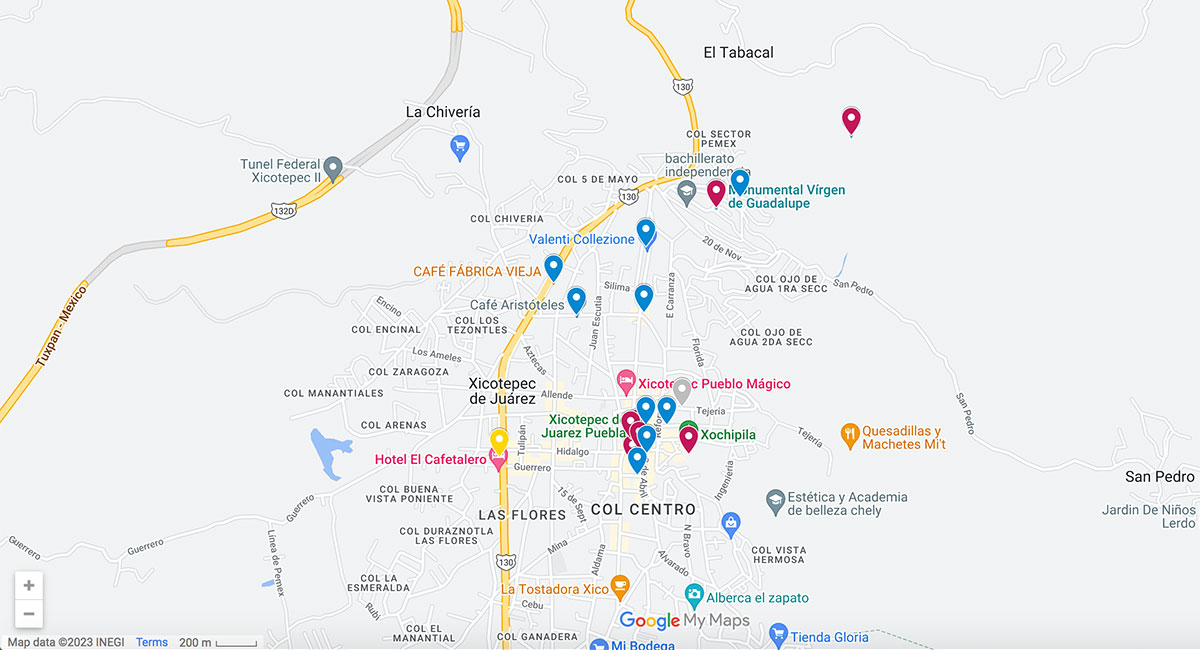
XICOTEPEC DE JUÁREZ ITINERARY
At the time of my visit, there were few buses between Puebla and Xicotepec de Juarez so I didn’t get into town until early in the evening. I stayed the night and left for Huauchinango in the middle of the afternoon the following day.
As long as you wake up early enough, then an overnight stay should be enough time for most people. Here’s a sample 1D/1N Xicotepec de Juarez itinerary to help you plan your trip.
| 1-DAY ITINERARY • Explore the zocalo • Parroquia de San Juan Bautista • Museo Casa Carranza • Xochipila • Monumental Virgen de Guadalupe • Majestuoso Cruz Celestial (if you have transportation) |
XICOTEPEC DE JUÁREZ TRAVEL TIPS
1. Stay Connected with a Mexico Sim Card or eSIM
Having a reliable internet connection is a must when traveling, especially when you’re visiting an off-the-beaten-path destination like Xicotepec de Juárez.
In my experience, pocket wifi devices don’t work well in Mexico so a SIM card is essential. Of all the networks, Telcel is widely regarded as the best while airalo is a trusted eSIM provider.
You can buy a Telcel SIM card anywhere in Mexico but you may want to order one before your trip through Amazon (affiliate link). It’ll be loaded with 3GB of data so you can hit the ground running as soon as you land in Mexico.
If you’d rather get an eSIM instead, then you get one in advance through airalo.
2. Learn Basic Spanish
You don’t have to be fluent in Spanish to appreciate Mexico but it definitely helps to know a few phrases. Here are some of the most commonly used phrases in Mexico:
Por favor: “Please”
(Muchas) gracias: “Thank you (very much)”
Buenos dias: “Good morning”
Buenas tardes: “Good afternoon”
Buenas noches: “Good evening”
Con permiso: “Excuse me” (when passing someone on the street)
Perdon/Desculpe: “Sorry” or “Excuse me” (when you didn’t hear what someone said)
¿Cuanto cuesta?: “How much does it cost?”
La cuenta por favor: “The bill please”
3. Bookmark the Puebla and Xicotepec de Juárez Tripadvisor Forums
Depending on where you are, safety can be a concern in Mexico so it’s important to always be informed. In my experience, one of the best ways to do that is to follow the Tripadvisor travel forum dedicated to the city you’ll be visiting. If there are any recent incidents you should know about, then there’s a good chance you’ll learn about them there first.
Click on the links to go to the Puebla and Xicotepec de Juarez travel forums on Tripadvisor. These forums are frequented by locals and expats so it’s a great place to ask any questions as well.
4. Start at the Tourist Information Center
Some of these infrequently visited pueblos magicos have little to no information online. One of the best ways to start your visit is to go to the Tourist Information Center shortly after arriving. They’re usually quite helpful and can offer lots of information on tours, transportation, attractions, and other travel-related services.
In Mexico, Tourist Information Centers are typically located around the zocalo. It’s the same in Xicotepec de Juarez.
5. Bring Cash
Some of these smaller pueblos magicos don’t have as many banks or ATM machines so it’s a good idea to bring enough cash with you.
6. Be Respectful Around Xochipila
Xochipila is a sacred site so it’s important to be respectful when you visit. Don’t climb up or down the shrine, keep your voices down, and pick up after yourselves.
7. Don’t Drink Tap Water
Tap water isn’t safe for drinking in Mexico so you should always buy bottled water or drink from a filtered water bottle. You don’t want to come down with a debilitating case of diarrhea so check out my article on the drinking water in Mexico for more information.
8. Leave a Tip
Like its neighbor to the north, there’s a tipping culture in Mexico but I find that it applies more to larger cities. In some of these smaller pueblos magicos, tipping doesn’t seem to be as expected (ie no tip jars).
Personally, I always leave a tip of around 10% of the total bill. You can read my article on tipping in Mexico for more tips.
9. Get Travel Insurance
I used to think that travel insurance wasn’t a necessity but I don’t think that way anymore. The fact is, you never know what might happen on a trip so it’s good to always be prepared.
For peace of mind, we suggest picking up a travel insurance policy from Heymondo (non-US residents get 5% off). Click on the link to learn more and get a free quotation.
10. Bring the Right Power Adapter
Mexico has Type A or Type B electrical outlets so be sure to bring the right power adapters for your devices. Electrical voltage is 127V and the standard frequency is 60Hz.
WHAT I LOVED ABOUT XICOTEPEC DE JUÁREZ
Before I let you go, I just wanted to share some of the things that I personally loved about Xicotepec de Juarez:
|
OUR TRAVEL GEAR
Here’s some of the travel equipment and gear I brought with me to Xicotepec de Juarez and Mexico. (Amazon affiliate links)
Disclosure
Some of the links in this travel guide to Xicotepec de Juárez, Puebla are affiliate links, meaning we’ll make a small commission if you make a purchase at no extra cost to you. As always, we only recommend products and services that we use ourselves. We really appreciate your support as it helps us keep this free Puebla travel website going. Thank you!






